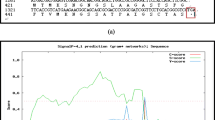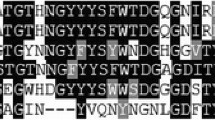Abstract
A xylanase gene, xynAS27, was isolated from a genomic library of Streptomyces sp. S27. The full-length gene consists of 1,434 bp and encodes 477 amino acids, including a putative signal peptide of 41 residues at its N-terminus. The mature xylanase comprises two functional domains, a family 10 glycoside hydrolase, and a family 13 carbohydrate-binding module (CBM), which were joined by a short Gly/Pro-rich linker region. The intact, the CBM-truncated and the CBM-linker-truncated versions of the mature proteins were expressed in Escherichia coli BL21 (DE3), purified to electrophoretic homogeneity and subsequently characterized. XynAS27 showed high pH stability over the pH range 2.2–12.0. XynAS27 may be a compelling tool for the food industry because it generates xylobiose (85% w/w) as the main product of xylan hydrolysis. The truncated versions showed less pH and thermal stability, and less affinity and hydrolytic activity to insoluble substrate than the intact one. These results indicate that the CBM of XynAS27 plays a key role in the hydrolysis of insoluble substrate, and the CBM and linker region are also important for the enzyme stability, and the linker region contributes more.




Similar content being viewed by others
References
Ali E, Araki R, Zhao G, Sakka M, Karita S, Kimura T, Sakka K (2005a) Functions of family-22 carbohydrate-binding modules in Clostridium josui Xyn10A. Biosci Biotechnol Biochem 69:2389–2394
Ali E, Zhao G, Sakka M, Kimura T, Ohmiya K, Sakka K (2005b) Functions of family-22 carbohydrate-binding module in Clostridium thermocellum Xyn10C. Biosci Biotechnol Biochem 69:160–165
Ali MK, Fukumura M, Sakano K, Karita S, Kimura T, Sakka K, Ohmiya K (1999) Cloning, sequencing, and expression of the gene encoding the Clostridium stercorarium xylanase C in Escherichia coli. Biosci Biotechnol Biochem 63:1596–1604
Ali MK, Hayashi H, Karita S, Goto M, Kimura T, Sakka K, Ohmiya K (2001) Importance of the carbohydrate-binding module of Clostridium stercorarium Xyn10B to xylan hydrolysis. Biosci Biotechnol Biochem 65:41–47
Biely P (1985) Microbial xylanolytic systems. Trends Biotechnol 3:286–290
Boraston AB, Bolam DN, Gilbert HJ, Davies GJ (2004) Carbohydrate-binding modules: fine-tuning polysaccharide recognition. Biochem J 382:769–781
Bottoli AP, Kertesz-Chaloupková K, Boulianne RP, Granado JD, Aebi M, Kües U (1999) Rapid isolation of genes from an indexed genomic library of C. cinereus in a novel pab1+ cosmid. J Microbiol Methods 35:129–141
Bradford MM (1976) A rapid and sensitive method for the quantitation of microgram quantities of protein utilizing the principle of protein–dye binding. Anal Biochem 72:248–254
Collins T, Gerday C, Feller G (2005) Xylanases, xylanase families and extremophilic xylanases. FEMS Microbiol Rev 29:3–23
Dias FMV, Goyal A, Gilbert HJ, Prates JAM, Ferreira LMA, Fontes CMGA (2004) The N-terminal family 22 carbohydrate-binding module of xylanase 10B of Clostridium themocellum is not a thermostabilizing domain. FEMS Microbiol Lett 238:71–78
Fujimoto Z, Kuno A, Kaneko S, Kobayashi H, Kusakabe I, Mizuno H (2002) Crystal structures of the sugar complexes of Streptomyces olivaceoviridis E-86 xylanase: sugar binding structure of the family 13 carbohydrate binding module. J Mol Biol 316:65–78
Fujimoto Z, Kuno A, Kaneko S, Yoshida S, Kobayashi H, Kusakabe I, Mizuno H (2000) Crystal structure of Streptomyces olivaceoviridis E-86 β-xylanase containing xylan-binding domain. J Mol Biol 300:575–585
Hazes B (1996) The (QxW)3 domain: a flexible lectin scaffold. Protein Sci 5:1490–1501
Irwin D, Jung ED, Wilson DB (1994) Characterization and sequence of a Thermomonospora fusca xylanase. Appl Environ Microbiol 60:763–770
Jeong KJ, Park IY, Kim MS, Kim SC (1998) High-level expression of an endoxylanase gene from Bacillus sp. in Bacillus subtilis DB104 for the production of xylobiose from xylan. Appl Microbiol Biotechnol 50:113–118
Jiang Z, Deng W, Yan Q, Zhai Q, Li L, Kusakabe I (2006) Subunit composition of a large xylanolytic complex (xylanosome) from Streptomyces olivaceoviridis E-86. J Biotechnol 126:304–312
Jiang ZQ, Deng W, Zhu YP, Li LT, Sheng YJ, Hayashi K (2004) The recombinant xylanase B of Thermotoga maritima is highly xylan specific and produces exclusively xylobiose from xylans, a unique character for industrial applications. J Mol Catal B Enzym 27:207–213
Johnson KG, Harrison BA, Schneider H, MacKenzie CR, Fontana JD (1988) Xylan-hydrolysing enzymes from Streptomyces spp. Enzyme Microb Technol 10:403–409
Kataeva IA, Blum DL, Li X-L, Ljungdahl LG (2001) Do domain interactions of glycosyl hydrolases from Clostridium thermocellum contribute to protein thermostability. Protein Eng 14:167–172
Laemmli UK (1970) Cleavage of structural proteins during the assembly of the head of bacteriophage T4. Nature 227:680–685
Li N, Meng K, Wang Y, Shi P, Luo H, Bai Y, Yang P, Yao B (2008a) Cloning, expression, and characterization of a new xylanase with broad temperature adaptability from Streptomyces sp. S9. Appl Microbiol Biotechnol 80:231–240
Li N, Shi P, Yang P, Wang Y, Luo H, Bai Y, Zhou Z, Yao B (2008b) Cloning, expression, and characterization of a new Streptomyces sp. S27 xylanase for which xylobiose is the main hydrolysis product. Appl Biochem Biotechnol doi:https://doi.org/10.1007/s12010-008-8411-0
Li N, Yang P, Wang Y, Luo H, Meng K, Wu N, Fan Y, Yao B (2008c) Cloning, expression, and characterization of protease-resistant xylanase from Streptomyces fradiae var. k11. J Microbiol Biotechnol 18:410–416
Mamo G, Hatti-Kaul R, Mattiasson B (2006) A thermostable alkaline active endo-β-1-4-xylanase from Bacillus halodurans S7: Purification and characterization. Enzyme Microb Technol 39:1492–1498
Mamo G, Hatti-Kaul R, Mattiasson B (2007) Fusion of carbohydrate binding modules from Thermotoga neapolitana with a family 10 xylanase from Bacillus halodurans S7. Extremophiles 11:169–177
Mangala SL, Kittur FS, Nishimoto M, Sakka K, Ohmiya K, Kitaoka M, Hayashi K (2003) Fusion of family VI cellulose binding domains to Bacillus halodurans xylanase increases its catalytic activity and substrate-binding capacity to insoluble xylan. J Mol Catal B Enzym 21:221–230
Miller GL (1959) Use of dinitrosalicylic acid reagent for determination of reducing sugar. Anal Chem 31:426–428
Moreau A, Roberge M, Manin C, Shareck F, Kluepfel D, Morosoli R (1994) Identification of two acidic residues involved in the catalysis of xylanase A from Streptomyces lividans. Biochem J 302:291–295
Morosoli R, Bertrand JL, Mondou F, Shareck F, Kluepfel D (1986) Purification and properties of a xylanase from Streptomyces lividans. Biochem J 239:587–592
Moure A, Gullón P, Domínguez H, Parajó JC (2006) Advances in the manufacture, purification and applications of xylo-oligosaccharides as food additives and nutraceuticals. Process Biochem 41:1913–1923
Ohmiya K, Sakka K, Karita S, Kimura T (1997) Structure of cellulases and their applications. Biotechnol Genet Eng Rev 14:365–414
Prade RA (1996) Xylanases: from biology to biotechnology. Biotechnol Genet Eng Rev 13:101–131
Ruiz-Arribas A, Fernández-Abalos JM, Sánchez P, Garda AL, Santamariá RI (1995) Overproduction, purification, and biochemical characterization of a xylanase (Xys1) from Streptomyces halstedii JM8. Appl Environ Microbiol 61:2414–2419
Ruiz-Arribas A, Sánchez P, Calvete JJ, Raida M, Fernández-Abalos JM, Santamaría RI (1997) Analysis of xysA, a gene from Streptomyces halstedii JM8 that encodes a 45-kilodalton modular xylanase, Xys1. Appl Environ Microbiol 63:2983–2988
Shareck F, Roy C, Yaguchi M, Morosoli R, Kluepfel D (1991) Sequences of three genes specifying xylanases in Streptomyces lividans. Gene 107:75–82
Sunna A, Gibbs MD, Berqquist PL (2000) A novel thermostable multidomain 1,4-beta-xylanase from ‘Caldibacillus cellulovorans’ and effect of its xylan-binding domain on enzyme activity. Microbiology 146:2947–2955
Tsujibo H, Miyamoto K, Kuda T, Minami K, Sakamoto T, Hasegawa T, Inamori Y (1992) Purification, properties, and partial amino acid sequences of thermostable xylanases from Streptomyces thermoviolaceus OPC-520. Appl Environ Microbiol 58:371–375
Vázquez MJ, Alonso JL, Domínguez H, Parajó JC (2000) Xylooligosaccharides: manufacture and applications. Trends Food Sci Technol 11:387–393
Zhang H, Yao B, Yuan T, Wang Y, Cao S, Fan Y (2002) Purification and properties of 43 kD xylanase XYNA from Streptomyces olivaceoviridis A1. J Agric Biotechnol 10:10–14 (in Chinese)
Acknowledgments
This work was supported by National High Technology Research and Development Program of China (863 Program; No. 2007AA100601) and National Key Technology R&D Program of China (No. 2006BAD12B05-03).
Author information
Authors and Affiliations
Corresponding author
Rights and permissions
About this article
Cite this article
Li, N., Shi, P., Yang, P. et al. A xylanase with high pH stability from Streptomyces sp. S27 and its carbohydrate-binding module with/without linker-region-truncated versions. Appl Microbiol Biotechnol 83, 99–107 (2009). https://doi.org/10.1007/s00253-008-1810-x
Received:
Revised:
Accepted:
Published:
Issue Date:
DOI: https://doi.org/10.1007/s00253-008-1810-x




